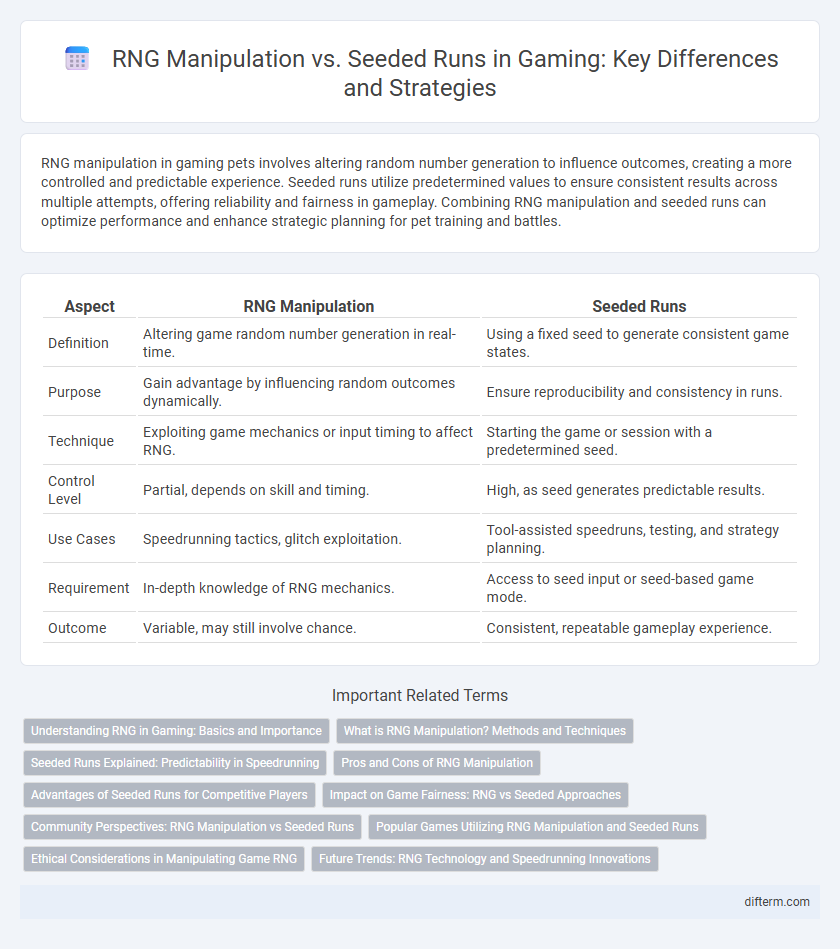RNG manipulation in gaming pets involves altering random number generation to influence outcomes, creating a more controlled and predictable experience. Seeded runs utilize predetermined values to ensure consistent results across multiple attempts, offering reliability and fairness in gameplay. Combining RNG manipulation and seeded runs can optimize performance and enhance strategic planning for pet training and battles.
Table of Comparison
| Aspect | RNG Manipulation | Seeded Runs |
|---|---|---|
| Definition | Altering game random number generation in real-time. | Using a fixed seed to generate consistent game states. |
| Purpose | Gain advantage by influencing random outcomes dynamically. | Ensure reproducibility and consistency in runs. |
| Technique | Exploiting game mechanics or input timing to affect RNG. | Starting the game or session with a predetermined seed. |
| Control Level | Partial, depends on skill and timing. | High, as seed generates predictable results. |
| Use Cases | Speedrunning tactics, glitch exploitation. | Tool-assisted speedruns, testing, and strategy planning. |
| Requirement | In-depth knowledge of RNG mechanics. | Access to seed input or seed-based game mode. |
| Outcome | Variable, may still involve chance. | Consistent, repeatable gameplay experience. |
Understanding RNG in Gaming: Basics and Importance
RNG, or Random Number Generation, is crucial in gaming for producing unpredictable outcomes such as loot drops, enemy behavior, and procedural content. Understanding RNG mechanics allows players to optimize strategies through RNG manipulation, increasing control over chance-based events compared to purely seeded runs, where outcomes follow predetermined sequences. This knowledge enhances gameplay by balancing fairness and player skill in games relying heavily on randomness.
What is RNG Manipulation? Methods and Techniques
RNG manipulation in gaming refers to the deliberate techniques used to influence or predict random number generator outcomes to gain an advantage or desired result. Common methods include frame-perfect inputs, controlled timing of actions, and exploiting known patterns within a game's RNG algorithm to ensure favorable events occur. These techniques often require deep understanding of game mechanics and precise execution to alter randomness in speedruns or competitive scenarios.
Seeded Runs Explained: Predictability in Speedrunning
Seeded runs in speedrunning offer a fixed starting point by using predetermined seeds, allowing runners to predict and optimize every segment of the game. This predictability contrasts with RNG manipulation, where players attempt to influence random number generation to gain favorable outcomes during an unpredictable run. By controlling the seed, speedrunners reduce randomness, enabling precise strategies and consistent record-setting performances.
Pros and Cons of RNG Manipulation
RNG manipulation in gaming allows players to influence random number generation outcomes to gain a strategic advantage, often speeding up progress and improving consistency in results. However, it can undermine the game's intended challenge, reduce replayability, and may be considered unethical or exploitative by developers and the gaming community. While it offers precise control over randomness, reliance on RNG manipulation can diminish the thrill and unpredictability that seeded runs preserve.
Advantages of Seeded Runs for Competitive Players
Seeded runs provide competitive players with consistent and predictable game conditions by using fixed random number generator (RNG) seeds, enabling precise strategy planning and execution. This stability reduces the impact of luck, allowing skill and preparation to play a more significant role in outcomes. Consequently, seeded runs facilitate fairer competition and improve the accuracy of performance comparisons among top players.
Impact on Game Fairness: RNG vs Seeded Approaches
RNG manipulation introduces variability by altering random number generation to favor specific outcomes, often undermining game fairness through unpredictability and potential exploits. Seeded runs utilize predetermined seeds to generate consistent, repeatable game states, ensuring balanced gameplay and transparent competition. The contrast in game fairness between RNG manipulation and seeded approaches primarily hinges on predictability, with seeded runs fostering equitable environments while RNG manipulation can lead to biased advantages.
Community Perspectives: RNG Manipulation vs Seeded Runs
Community perspectives on RNG manipulation emphasize skillful exploitation of random number generation to gain advantages, often seen as a legitimate challenge in speedrunning. Seeded runs focus on predetermined conditions, offering consistency and fairness that fosters inclusivity and competition among players. Debates center around fairness, skill expression, and the impact on leaderboards, reflecting diverse values within the gaming community.
Popular Games Utilizing RNG Manipulation and Seeded Runs
Popular games like "The Binding of Isaac," "Enter the Gungeon," and "Hades" extensively utilize RNG manipulation techniques to influence item drops, enemy behavior, and room layouts, giving skilled players strategic control over randomness. Seeded runs in titles such as "Spelunky 2" and "Minecraft" offer predetermined world or level generation, enabling consistent speedrunning conditions and community competition. Both RNG manipulation and seeded runs significantly impact gameplay strategies and leaderboard rankings in the speedrunning and competitive gaming scenes.
Ethical Considerations in Manipulating Game RNG
Manipulating game RNG raises ethical concerns about fairness and player trust, as it can provide unfair advantages and diminish the game's intended challenge. Seeded runs rely on predetermined outcomes to ensure consistency, while RNG manipulation actively alters random elements, potentially leading to exploitation. Developers and players must consider transparency and respect for the game's design to maintain integrity within the gaming community.
Future Trends: RNG Technology and Speedrunning Innovations
Advancements in RNG technology are enhancing precision control in seeded runs, allowing speedrunners to manipulate outcomes with unprecedented accuracy. Emerging AI-driven algorithms enable real-time RNG adjustments and adaptive strategies during live gameplay, pushing the boundaries of speedrunning techniques. These innovations promise a future where the interplay between randomness and skill is finely balanced, fostering new competitive formats and community-driven challenges.
RNG Manipulation vs Seeded Runs Infographic

 difterm.com
difterm.com